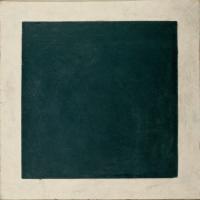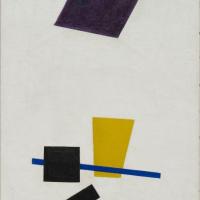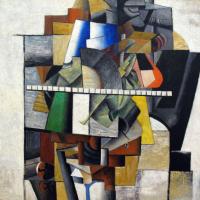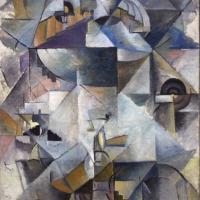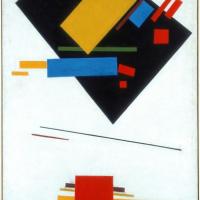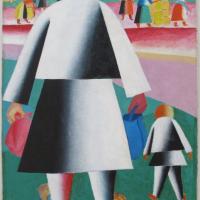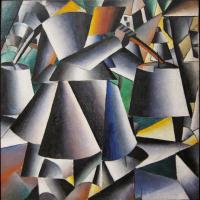Kazimir Malevich
Black Square
$510.00
Dynamic Suprematism
$510.00
Samovar
$450.00
Suprametism
$450.00
Suprematism
$450.00
Suprematismo
$450.00
Suprematist Composition
$450.00
Verso La Vendemmia
$450.00
Woman drying herself
$510.00
Kazimir Malevich
Kazimir Malevich (1879-1935)
Kazimir Severinovich Malevich (February 23 or 11 1879 – May 15, 1935) was a Russian avant-garde artist and art theorist, whose pioneering work and writing had a profound influence on the development of non-objective, or abstract art, in the 20th century. Born in Kiev to an ethnic Polish family, his concept of Suprematism sought to develop a form of expression that moved as far as possible from the world of natural forms (objectivity) and subject matter in order to access "the supremacy of pure feeling" and spirituality.
Early on, Malevich worked in a variety of styles, quickly assimilating the movements of Impressionism, Symbolism and Fauvism, and after visiting Paris in 1912, Cubism. Gradually simplifying his style, he developed an approach with key works consisting of pure geometric forms and their relationships to one another, set against minimal grounds. His Black Square (1915), a black square on white, represented the most radically abstract painting known to have been created so far and drew "an uncrossable line (…) between old art and new art"; Suprematist Composition: White on White (1918), a barely differentiated off-white square superimposed on an off-white ground, would take his ideal of pure abstraction to its logical conclusion. In addition to his paintings, Malevich laid down his theories in writing, such as "From Cubism and Futurism to Suprematism" (1915) and The Non-Objective World: The Manifesto of Suprematism (1926).
Malevich's trajectory in many ways mirrored the tumult of the decades surrounding the October Revolution (O.S.) in 1917. In its immediate aftermath, vanguard movements such as Suprematism and Vladimir Tatlin's Constructivism were encouraged by Trotskyite factions in the government. Malevich held several prominent teaching positions and received a solo show at the Sixteenth State Exhibition in Moscow in 1919. His recognition spread to the West with solo exhibitions in Warsaw and Berlin in 1927. Upon his return, modern art was falling out of favor with the new government of Joseph Stalin. Malevich soon lost his teaching position, artworks and manuscripts were confiscated, and he was banned from making art. In 1930, he was imprisoned for two months due to suspicions raised by his trip to Poland and Germany. Forced to abandon abstraction, he painted in a representational style in the years before his death from cancer in 1935, at the age of 56.
Nonetheless, his art and his writing influenced contemporaries such as El Lissitzky, Lyubov Popova and Alexander Rodchenko, as well as generations of later abstract artists, such as Ad Reinhardt and the Minimalists. He was celebrated posthumously in major exhibits at the Museum of Modern Art(1936), the Guggenheim Museum (1973) and the Stedelijk Museum in Amsterdam (1989), which has a large collection of his work. In the 1990s, the ownership claims of museums to many Malevich works began to be disputed by his heirs.
Alfred H. Barr Jr. included several paintings in the groundbreaking exhibition "Cubism and Abstract Art" at the Museum of Modern Art in New York in 1936. In 1939, the Museum of Non-Objective Painting opened in New York, whose founder, Solomon R. Guggenheim—an early and passionate collector of the Russian avant-garde—was inspired by the same aesthetic ideals and spiritual quest that exemplified Malevich’s art.
The first U.S. retrospective of Malevich's work in 1973 at the Solomon R. Guggenheim Museum provoked a flood of interest and further intensified his impact on postwar American and European artists. However, most of Malevich’s work and the story of the Russian avant-garde remained under lock and key until Glasnost. In 1989, the Stedelijk Museum in Amsterdam held the West’s first large-scale Malevich retrospective, including its own paintings and works from the collection of Russian art critic Nikolai Khardzhiev.
Malevich's works are held in several major art museums, including the State Tretyakov Gallery in Moscow, and in New York, the Museum of Modern Art and the Guggenheim Museum. The Stedelijk Museum in Amsterdam owns 24 Malevich paintings, more than any other museum outside of Russia. Another major collection of Malevich works is held by the State Museum of Contemporary Art in Thessaloniki.
Black Square, the fourth version of his magnum opus painted in the 1920s, was discovered in 1993 in Samara and purchased by Inkombank for US$250,000. In April 2002 the painting was auctioned for an equivalent of US$1 million. The purchase was financed by the Russian philanthropist Vladimir Potanin, who donated funds to the Russian Ministry of Culture, and ultimately, to the State Hermitage Museum collection. According to the Hermitage website, this was the largest private contribution to state art museums since the October Revolution.
On 3 November 2008 a work by Malevich entitled Suprematist Composition from 1916 set the world record for any Russian work of art and any work sold at auction for that year, selling at Sotheby's in New York City for just over US$60 million (surpassing his previous record of US$17 million set in 2000).
In May 2018, his painting Suprematist Composition sold at Christie's New York for over US$85 million (including fees), a record auction price for a Russian work of art.
Malevich's life inspires many references featuring events and the paintings as players. The smuggling of Malevich paintings out of Russia is a key to the plot line of writer Martin Cruz Smith's thriller Red Square. Noah Charney's novel, The Art Thief tells the story of two stolen Malevich White on White paintings, and discusses the implications of Malevich's radical Suprematist compositions on the art world. British artist Keith Coventry has used Malevich's paintings to make comments on modernism, in particular his Estate Paintings. .Malevich's work also is featured prominently in the Lars Von Trier film, Melancholia.


